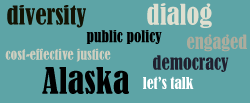Author:
Note: You can read the article on the ADN site here. Board member Cliff Groh is quoted as part of this article.
Shortly before his death in 2005, Jay Hammond concisely expressed his vision for the Alaska Permanent Fund.
“I wanted to transform oil wells pumping oil for a finite period into money wells pumping money for infinity,” the former Alaska governor wrote.
For the first time since the Permanent Fund was created in 1976, the state of Alaska is seriously considering a step away from that vision. Gov. Mike Dunleavy has proposed spending billions from the fund to pay for a $5,000 stimulus in 2021. Such a stimulus is badly needed, economists say: Unemployment is high, thousands of Alaskans aren’t caught up on their rent and many residents don’t have enough to eat.
That stimulus would have a long-term cost. The Permanent Fund’s investment earnings now account for over 70% of state revenue. Spending more from the fund means less money to invest and bigger deficits in the future. In turn, that would mean more tax increases and cuts to services.
The debate between short-term needs and long-term needs is expected to consume the opening months of next year’s legislative session because Dunleavy is requesting action by March.
To short-circuit that argument, some state experts are suggesting a third way: Short-term spending now, but an agreement on future tax increases to reduce deficits in the long run.
In 2018, lawmakers passed a bill that created an annual transfer from the Permanent Fund to the state treasury, and that money has kept the state afloat even as oil tax revenue has crashed.
In the fiscal year that starts July 1, oil will provide 19% of the state’s revenue, the lowest figure since 1960, according to state projections and historical figures kept by the nonpartisan Legislative Finance Division. The annual transfer from the Permanent Fund will account for 71% of the money the state spends on schools, roads, health care and other services.
Because the Permanent Fund is now so important to state revenue, lawmakers have taken extraordinary efforts to follow the 2018 law, even if it means cutting the Permanent Fund dividend in the process. (This year, state tax revenue has dropped so much that Alaska will likely have a small deficit even with no dividend.)
Many lawmakers have kept $100 billion as a target in their minds.
If the Alaska Permanent Fund reaches $100 billion, an average of $5 billion per year would flow from the fund to the treasury under the 2018 law, enough to pay for services and a small dividend.
If the fund keeps growing, the transfer would grow as well, keeping pace with inflation and services needed as the state’s population grows. The state could keep running without a sales tax, an income tax or higher taxes on oil companies.
The problem is getting to $100 billion.
On Nov. 30, the fund stood at $73 billion, and the Permanent Fund’s tentative forecasts indicate it will not reach $80 billion until 2030. Less than two weeks after the fund hit $73 billion, Dunleavy suggested his $6.2 billion spending plan.
The fund has enough money to pay for the plan — its value has risen significantly this year — but the governor’s proposal is about double the spending limit approved by lawmakers in 2018 and would drop the fund’s value.
“What the governor is proposing is that we take nearly 10% of the fund in one fell swoop, which I think will result in a significant loss to the overall value of the Permanent Fund, and that extreme whack at the fund, it will most certainly affect the future,” said state Sen. Natasha von Imhof, R-Anchorage.
The fund has earned an average of 6.44% annually over the past five years. Spending an extra $3 billion this year would cost the state over $1.9 billion in missed earnings over the next 10 years.
“How do you get to $100 billion if you take 10% of it in one fell swoop?” von Imhof said.
“As a realistic matter, it might make it impossible to get there,” said Rep. Zack Fields, D-Anchorage.
Since 1976, the fund has been capitalized by oil revenue, mostly from Prudhoe Bay, and Fields said Alaskans shouldn’t expect another Prudhoe Bay.
“I mean, you don’t want to plan on wishful thinking. I hope that happens, that would be great. But, you know, you don’t want your whole future to be contingent on that,” he said.
Others say the crisis happening now is more important than what might happen in the future.


